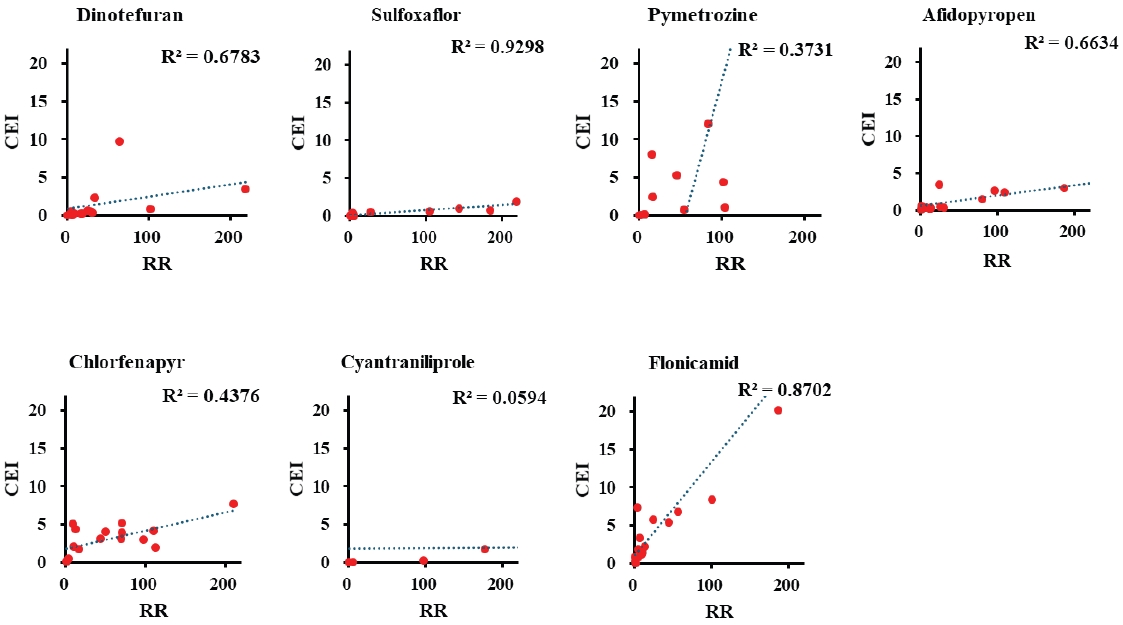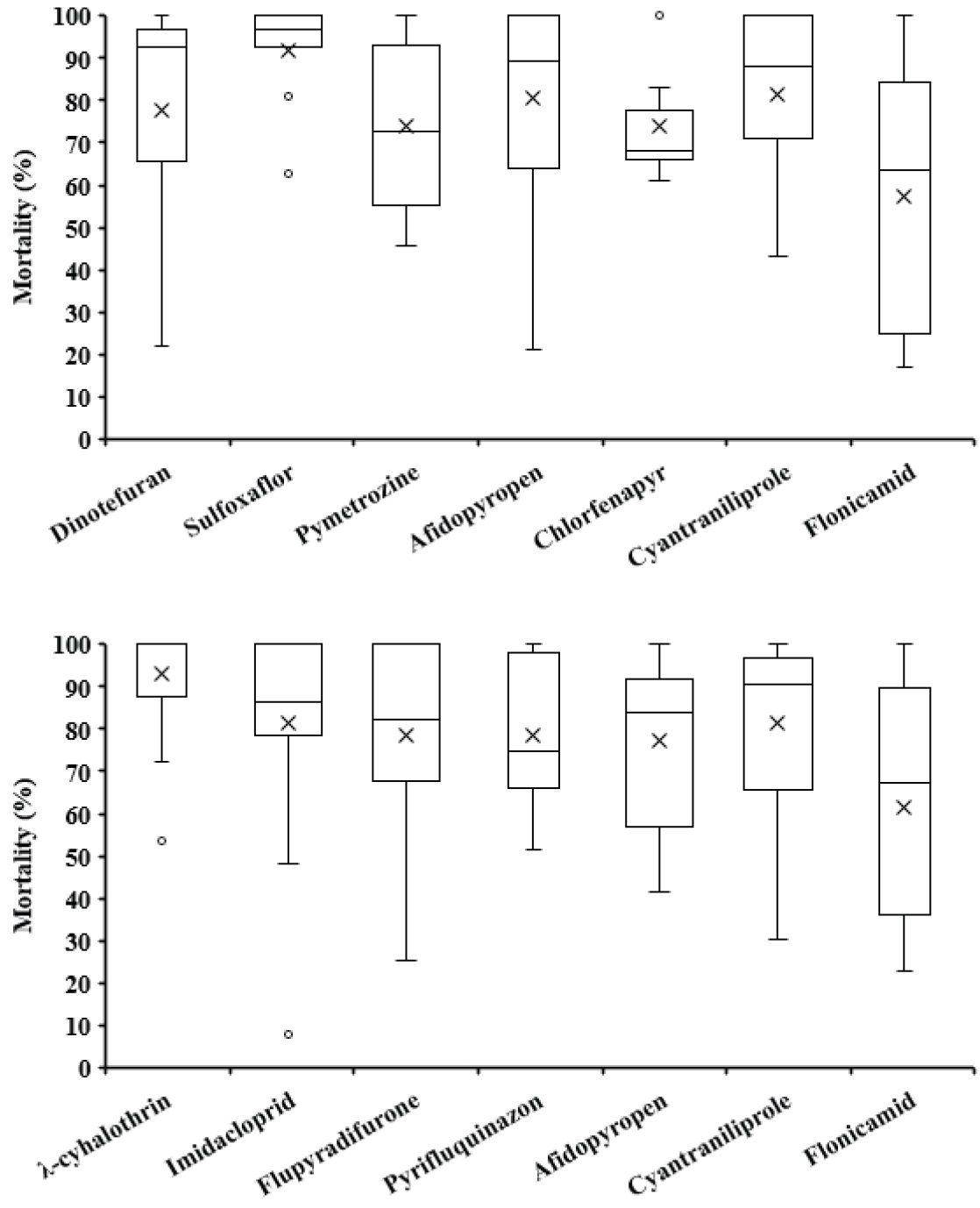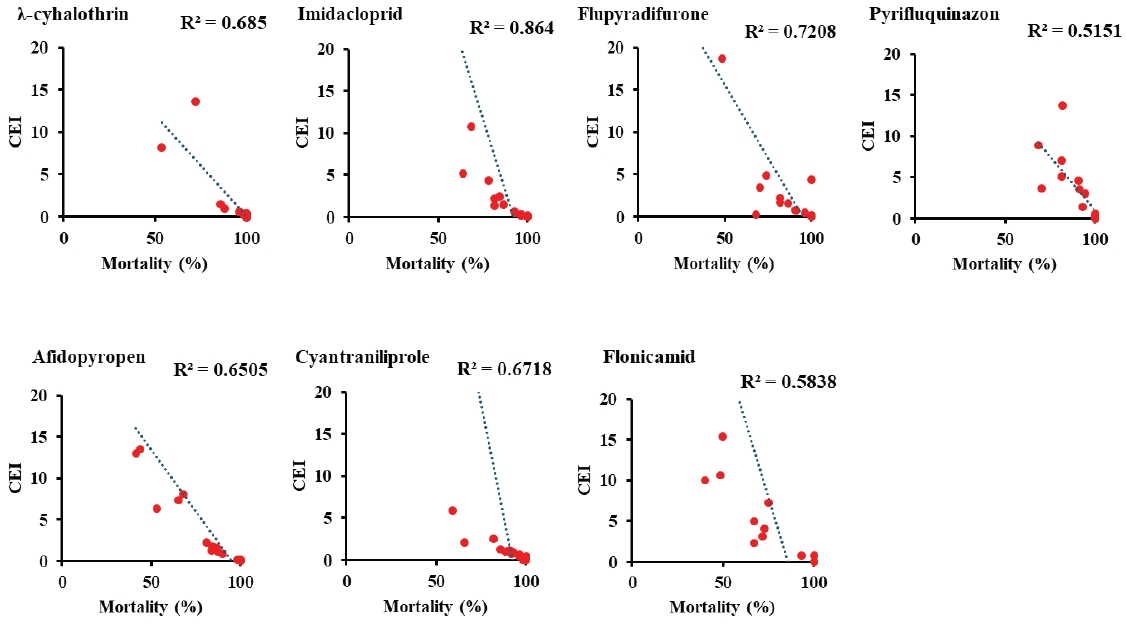
목화진딧물 야외집단에 대한 11종 약제의 방제효과지수를 이용한 저항성 평가 및 교차저항성 분석
초록
본 연구에서는 각각 15개 지역의 오이 및 고추 재배지에서 채집한 목화진딧물에 대해 등록된 11개 약제의 저항성비(resistance ratio, RR)와 방제 효과지수(control efficacy index, CEI)의 회귀분석과 상관관계 분석을 통해 약제간의 교차저항성 관계를 조사하였다. 저항성 수준 평가 결과, 일부 집단에서 높은 RR 값을 보임에도 불구하고 CEI는 1 미만으로 나타났다. 또한, 회귀분석 결과, RR과 CEI는 독립적인 지수임을 확인하였다. 추천농도에서 살충활성을 상자 수염그림(box and whisker plot)으로 비교한 결과, CEI와 유사한 패턴을 나타냈다. 약제별 LC50 값을 이용하여 Pearson 상관분석을 통해 교차저항성 관계를 확인한 결과, 유사한 기작을 가진 약제끼리 교차저항성 관계가 나타났으며, 오이에서 채집한 야외집단에서 cyantrailiprole 약제는 dinotefuran, sulfoxaflor, afidopyropen과 교차저항성 관계를 나타냈다. 따라서, CEI는 약제 효력평가와 해충 저항성 모니터링에 유용한 지표로 활용될 수 있다.
Abstract
This study investigated resistance ratios (RR) and control efficacy indices (CEI) of 11 registered insecticides in Aphis gossypii populations collected from 15 cucumber and pepper fields. Regression and correlation analyses were performed to examine the cross-resistance relationships among the insecticides. In the resistance,CEI was low, despite some populations showing high RR values. Additionally, regression analysis confirmed that RR and CEI are independent indices. Using box and whisker plots, a comparison of insecticidal efficacy at recommended concentrations showed a pattern similar to that of CEI. The pearson correlation analysis of LC50 values indicated cross-resistance relationships among insecticides with similar modes of action, with cyantraniliprole showing cross-resistance with dinotefuran, sulfoxaflor, and afidopyropen in cucumber field populations. This study suggests that CEI can be further utilized as a useful indicator for evaluating insecticide efficacy and resistance monitoring
Keywords:
Aphis gossypii, insecticide, resistance ratio, control efficacy index, cross-resistance키워드:
목화진딧물, 살충제, 저항성비, 방제 효과지수, 교차저항성서 론
목화진딧물(Aphis gossypii Glover)은 주요 농업 해충으로 주로 화학 살충제에 의해 방제되고 있으나, 진딧물의 짧은 세대주기와 높은 번식력으로 인해 약제 저항성이 빠르게 발현되고있다(Blackman and Eastop, 1984; Gore et al., 2013). 국내 야외집단 목화진딧물의 약제 저항성에 대한 연구는 소수에 불과하며, 대부분 피레스로이드계와 네오니코티노이드계 약제에 집중되어 있다(Koo et al., 2014; Lee et al., 2022; Nam et al., 2022).
약제 저항성에 대해 IRAC (Insecticide Resistance Action Committee)에서는 등록 약제가 대상 해충에 대해 권장 사용량으로 사용되었을 때 기대되는 방제 수준을 달성하지 못하는 상태로 정의하였다(IRAC, 2020). 많은 약제 저항성 연구에서 저항성비(resistance ratio, RR)을 통해 저항성을 평가하였으나(Gore et al., 2013; Koo et al., 2014; Zhang et al., 2016; Kang et al., 2023), RR은 감수성 계통의 존재 여부와 그 신뢰성에 문제가 있을 수 있으며, 상대적인 값이기 때문에 IRAC에서 정의한 저항성 개념을 포함하지 못했다. 이러한 이유로 몇몇 연구자들은 RR을 대체할 새로운 지수들인(resistance degree, pesticide efficacy index, control efficacy index, security index) 등을 제안하였다(Choi and Kim, 1986; Jeong et al., 2017; Kang et al., 2023; Stará et al., 2023).
차저항성(cross-resistance)은 단일 저항성 유전자가 2종 이상의 약제에 저항성을 보이는 것으로, 한 종류의 약제에 대한 저항성을 가진 해충이 유사한 작용 기작을 가진 다른 약제에도 저항성을 보이는 현상을 말한다(Kim et al., 2014; IRAC, 2020). 교차저항성 연구는 약제를 효과적으로 사용하기 위한 정보를 제공하여 해충 방제전략의 효율성을 높일 수 있다. 이러한 이유로 많은 연구자들은 단일 저항성이 발달한 해충을 대상으로 교차저항성을 조사하였다(Raghavendra et al., 2011; Koo et al., 2014; Chen et al., 2020; Zeng et al., 2021). 본 연구에서는 해충 방제전략의 효율성을 높이기 위해 야외 집단에서의 교차저항성 발달 양상을 조사하는 것이 중요하다고 생각하여, 야외 집단을 대상으로 Pearson 상관계수를 통해 교차저항성 유무를 분석하였다.
따라서, 이전 모니터링 연구를 확장하여, 각각 15개 지역의 오이 및 고추 재배지에서 채집한 목화진딧물에 대해 등록된 약제(오이 7종, 고추 7종)의 저항성과 교차저항성 관계를 조사하였다(Kang et al., 2023). 저항성 평가는 RR과 방제 효과지수(control efficacy index, CEI)를 이용하였다. 또한, 약제별 LC50 값을 이용하여 약제간 교차저항성 관계를 확인하였다. 이러한 저항성 평가를 통해 목화진딧물 야외집단의 저항성 발달 여부를 파악하고, 교차저항성 유무를 확인함으로써 야외집단 목화진딧물의 저항성 발달 양상을 이해하는데 중요한 정보를 제공하고자 한다.
재료 및 방법
시험곤충
감수성 계통(S)은 2022년 국립 농업과학원 곤충사육실에서 분양 받았으며, 야외집단 목화진딧물은 2022년, 2023년에 오이 및 고추 재배지 각각 15곳(오이: 화성(HS), 안성(AS), 평택(PT), 공주(GJ), 청주1(CJ 1), 충주(ChJ), 영월(YW), 횡성(HoS), 춘천(CC), 함양(HY), 경주(GyJ), 예천(YC), 목포(MP), 순천(SuC), 구례(GR); 고추: 인천(IC), 김포(GP), 여주(YJ), 청주2(CJ 2), 천안(CA), 진천(JC), 고성(GS), 양양(YY), 속초(SC), 군위(GW), 울산(US), 산청(SaC), 완주(WJ), 나주(NJ), 전주(JJ))에서 채집하였다(Kang et al., 2023). 감수성 계통과 야외집단은 곤충 사육실(온도, 23-25 ℃; 광주기, 16:8(L:D); 상대습도, 60-70 %)에서 아크릴 케이지(30 Ⅹ 30 Ⅹ30 cm)에 오이 및 고추 유모를 넣어 사육하였다.
시험약제
오이에 등록된 약제 7종(dinotefuran, sulfoxaflor, pymetrozine, afidopyropen, chlorfenapyr, cyantraniliprole, flonicamid)와 고추에 등록된 약제 7종(λ-cyhalothrin, imidacloprid, flupyradifurone, pyrifluquinazon, afidopyropen, cyantraniliprole, flonicamid)을 시험에 사용하였으며, 약제들에 대한 정보는 Table 1과 같다.
감수성 평가
약제 감수성 평가는 엽침지법(leaf dipping method)을 수행하였다. 오이 잎(ø 5.0 cm) 절편을 희석한 약제(40ml)에 30초간 침지한 후, 20분 동안 음건시켰다. 음건된 잎 절편을 1.5 % agar가 도포된 패트리디쉬(ø 5.0 cm)에 잎 뒷면이 위로 올라가도록 배치하고, 목화진딧물 성충 20마리를 접종하였다. 패트리디쉬는 온도 23-25 ℃, 광주기 16:8 (L:D), 상대습도 60-70 % 조건의 챔버에 보관하였다. 접종 후 72시간 뒤에 생충수를 조사하였으며, 실험은 3반복으로 진행하였다.
약제 저항성을 평가하기 위해 저항성비(resistance ratio, RR)와 방제 효과지수(control efficacy index, CEI)를 사용하였다(Kang et al., 2023).
- RR = LC50 of field population / LC50 of susceptible strain.
- CEI = LC90 of field population / recommended concentration of insecticide.
CEI가 1이하면 감수성, 1초과 2이하면 경도 저항성, 2초과 5미만이면 중도 저항성, 5이상이면 고도 저항성으로 판단하였다(Kang et al., 2023).
자료분석
사충률(mortality)는 Abbott’s fomula를 이용하여 보정사충률을 구했으며, LC50, LC90 값은 probit analysis를 이용하여 계산하였다(Abbott, 1925; SAS Institute, 2019). 약제별 교차저항성 관계는 SPSS (Version 26)을 이용하여 Pearson correlation coefficient를 통해 분석 하였다(George and Mallery, 2019). 엑셀에서 회귀분석을 통해 CEI와 RR, 그리고 CEI와 추천농도에서의 사충률 간의 선형적 관계를 분석하였다(MS, 2018).
결과 및 고찰
방제 효과지수와 저항성비 및 추천농도에서 사충률의 회귀분석
이전 연구에 이어(Kang et al., 2023), 이번 연구에서는 오이 재배지에서 채집한 SuC 및 GR집단과 고추 재배지에서 채집한 YY, SC, GW, US, SaC, WJ, NJ, JJ 집단의 목화진딧물에 대한 감수성을 추가적으로 평가하였다(Table 2, 3). 이전 연구와 마찬가지로, 집단에 따라 각 약제에 대한 감수성은 많은 차이를 보였으며, 대부분의 야외집단 목화진딧물들은 감수성 계통(S)보다 높은 LC50 및 LC90 값을 보였다.
모니터링 결과에서 약제 저항성을 평가하는데 저항성비(resistance ratio, RR)가 적합하지 않다고 판단되어 방제 효과지수(control efficacy index, CEI)를 이용하였다(Kang et al., 2023). 오이 재배지에서 채집한 집단 중, CJ, GR, HS, HY, GJ 집단에서는 100 이상의 RR 값을 나타냈지만, CJ, GR, HS 집단에서는 CEI가 1미만으로 감수성을 나타냈다. Cyantraniliprole 약제의 경우, HS, ChJ, YC, GJ, PT 집단에서 100 이상의 RR 값을 나타냈지만, HS과 ChJ 집단에서는 CEI가 1미만으로 감수성을 나타냈다. 고추 재배지에서 채집한 집단 중, λ-cyhalothrin의 경우, JC, YY, SaC, WJ, NJ, JJ 집단에서 100 이상의 RR 값을 나타냈지만, 모두 CEI가 1 미만으로 감수성을 나타냈다. 반면, flonicamid 약제의 경우, IC, SC, YY, GW, US, NJ 집단에서 100 이하의 RR 값을 나타냈지만, YY 집단은 경도 저항성, SC, GW, US, NJ 집단에서는 중도 저항성, IC 집단에서는 고도 저항성을 나타냈다(Table 4, 5). 이와 같이 RR 과 CEI는 항상 일치하지 않음을 확인하였다.
다음은 회귀분석을 통해 두 지수의 관계를 평가하였다(Fig. 1과 2). 오이 재배지에서 채집한 집단에서는 pymetrozine, chlorfenapyr, cyantraniliprole 약제와 고추 재배지에서 채집한 집단에서는 λ-cyhalothrin, pyrifluzuinazon 약제에서 R2 값이 0.45 미만으로 선형적 관계가 낮게 나타났다. 이러한 결과는 RR과 CEI는 항상 선형적 관계가 아닌 독립적인 지수임을 나타낸다. RR과 CEI는 모두 저항성 발달 수준을 평가하는데 이용하는 지수지만, 서로 다른 의미를 가지는 것을 확인할 수 있다(Kang et al., 2023). 저항성 평가 및 판단에 있어, RR은 점 돌연변이 유무, 해독효소 발현량의 차이 등 집단 간 차이를 비교할 때 적합하며, CEI는 해충에 대한 약제의 효력을 평가하거나, 야외집단의 해충이 약제에 대해 저항성이 얼마나 발달했는지 평가하는 모니터링 연구에 적합하다고 생각된다. 다른 연구자들도 모니터링 연구에서 RR이 적합하지 않다고 판단하여 다른 지수들을 제안하기도 하였다(Jeong et al., 2017; Stará et al., 2023). Jeong 등(2017) 은 야외 집단 배추좀나방(Plutella xylostella)에 대해 추천농도에서 등록 약제의 효력을 평가하기 위해 약제효력지수(pesticide efficacy index, PEI)라는 개념을 도입하였다. 또한, Stará 등(2023)은 약제의 추천농도를 야외집단의 LC90 값으로 나눈 Security index (SI)를 제시하였다. PEI와 SI 모두 약제의 효력을 평가하는 모니터링 연구에 적합하지만, 이 두 지수들은 효과 유무만을 평가할 수 있다. 반면 CEI는 수치에 따라 감수성, 경도 저항성, 중도 저항성, 고도 저항성으로 세분화 하여 등록 약제의 효력을 평가하여 해충의 저항성 발달 정도를 평가하는데 사용할 수 있다.

Regression analysis between resistance ratio (RR) and Control efficacy index (CEI) of Aphis gossypii collected from cucumbers.

Regression analysis between resistance ratio (RR) and control efficacy index (CEI) of Aphis gossypii collected from peppers.
본 연구에서 추천농도의 살충활성을 상자 수염그림(box and whisker plot)으로 비교한 결과, CEI와 유사한 패턴을 나타냈다. 예를 들어, sulfoxaflor 약제의 경우, GJ (3.2), HY (1.9) 집단을 제외하고 모두 1 미만의 CEI를 나타냈으며, 상자 수염그림에서는 최소값이 92.8 %를 나타냈다(Fig. 3). Dinotefuran 약제의 경우, 10개의 집단에서 1 미만의 CEI를 보였으나, GJ (12.2), HY (30.4), SuC (9.8) 집단에서 5 이상의 CEI를 나타냈고, 상자수염 그림에서는 중앙값이 92.6 %인 반면 최소값이 21.9 %였다. Chlorfenapyr 약제의 경우, 10개 집단에서 경도 및 중도 저항성이 나타났으며, 상자 수염그림에서도 사분위범위가 66.1~77.6 %로 나타났다. CEI와 추천농도에서의 사충률을 회귀분석 했을 때, 오이에서 채집한 집단의 경우, 모든 약제에서 R2 값이 0.6 이상으로 높은 선형적 관계가 나타났다(Fig. 4). 고추에서 채집한 집단의 경우, pyrifluquinazon과 flonicamid 약제에서 R2 값이 0.45 이상으로 선형적 관계가 나타났으며, 나머지 약제들은 R2 값이 0.6 이상으로 높은 선형적 관계가 나타났다(Fig. 5). 이러한 결과는 CEI가 추천농도에서 약제의 효력을 평가할 수 있음을 시사하며, 이는 IRAC에서 정의한 저항성 개념에 부합하는 평가 기준이 될 수 있음을 보여준다. 따라서, CEI는 약제 효력 평가와 해충 저항성 모니터링에 유용한 지표로 활용될 수 있다.

Mean of mortality comparisons from each 15 regional populations which was collected from cucumber cultivation (A) and pepper cultivation (B). x, mean of mortality for total regional populations.

Regression analysis between mortality at recommended concentration and control efficacy index (CEI) of Aphis gossypii collected from cucumbers.
Peason 상관계수를 통한 야외집단 목화진딧물의 교차저항성 분석
지금까지 교차저항성 연구들은 단일 저항성을 가진 해충에 대해 다른 약제를 실험하여 교차저항성 관계를 찾는 데 중점을 두었다(Raghavendra et al., 2011; Foster et al., 2012; Koo et al., 2014; Chen et al., 2020). 이러한 연구들은 해충 방제 전략을 세우는데 중요한 정보를 제공하지만 야외 포장에서 해충이 여러 약제에 저항성이 어떻게 발달했는지 평가하는 것도 필요하다고 판단하였다. 실제 야외에서의 해충 저항성 발달 상태를 파악함으로써 보다 현실적이고 효과적인 방제전략을 수립할 수 있다. 예를 들어, 오이와 고추 재배지에서 채집한 목화진딧물 집단에 대한 본 연구 결과는 현재 야외집단의 목화진딧물이 다양한 약제에 대해 어떻게 저항성이 발달했는지 보여준다. 네오니코티노이드계 약제인 dinotefuran (4a)과 sulfoxaflor (4c)는 0.65 이상의 높은 상관관계(p<0.01)을 보여 교차저항성 관계가 있음을 나타냈다. 또한, 현음기관을 교란시키는 pymetrozine (9b), afidopyropen (9d), flonicamid (29)는 각각 0.646 (p<0.01), 0.609 (p<0.05), 0.654 (p<0.01)로 높은 상관관계를 보여 교차저항성 관계가 있음을 확인하였다. 한편, diamide계 약제인 cyantraniliprole (28)은 dinotefuran (4a), sulfoxaflor (4c)와 afidopyropen (9d)에 각각 0.671 (p<0.01), 0.726 (p<0.01), 0.562 (p<0.05)로 교차저항성 관계가 확인되었다(Table 6). 고추 재배지에서 채집한 목화진딧물 집단에서도 유사한 결과가 나타났다. Afidopyropen (9d)는 pyrifluquinazon (9b)와 flonicamid (29)에 각각 0.552 (p<0.05), 0.669 (p<0.01)로 높은 상관관계를 보여 교차저항성 관계가 있음을 나타냈다(Table 7). 이러한 결과는 현재 야외 포장에서 목화진딧물의 저항성 발달 상태를 보여준다. 중국에서는 afidopyropen 약제에 저항성이 발달한 목화진딧물에 대한 교차저항성 연구 결과, afidopyropen 약제는 다른 약제들과 교차저항성이 없다고 보고하였다(Zha et al., 2024). 이러한 결과를 종합하면, 기존의 단일 약제에 대한 저항성을 조사하는 연구와 함께 다양한 약제에 대한 저항성 발달 양상을 조사하는 연구를 병행한다면, 현실적이고 효과적인 해충 방제전략을 위한 기초 자료를 제공할 수 있을 것이다.
Acknowledgments
본 논문은 농촌진흥청의 소면적작물 농약직권등록 중 농자재관리 및 평가사업의 지원을 받아 연구되었습니다(RS-2022-RD010420).
이해상충관계
저자는 이해상충관계가 없음을 선언합니다.
References
-
Abbott WS, 1925. A method of computing the effectiveness of an insecticide. J. Econ. Entomol. 18(2), 265–267.
[https://doi.org/10.1093/jee/18.2.265a]

- Blackman RL, Eastop VF, 1984. Aphids on the World’s Crops: An Identification and Information Guide. Wiley.
-
Chen A, Zhang H, Shan T, Shi X, Gao X, 2020. The overexpression of three cytochrome P450 genes CYP6CY14, CYP6CY22 and CYP6UN1 contributed to metabolic resistance to dinotefuran in melon/cotton aphid, Aphis gossypii Glover. Pestic. Biochem. Physiol. 167, 104601.
[https://doi.org/10.1016/j.pestbp.2020.104601]

- Choi SY, Kim GH, 1986. Studies on the resistance of green peach aphids to insecticides (II)-local differences in susceptibility. Korean J. Appl. Entomol. 24(4). 223-230
-
Foster SP, Denholm I, Rison JL, Portillo HE, Margaritopoulis J, et al., 2012. Susceptibility of standard clones and European field populations of the green peach aphid, Myzus persicae, and the cotton aphid, Aphis gossypii (Hemiptera: Aphididae), to the novel anthranilic diamide insecticide cyantraniliprole. Pest Manag. Sci. 68(4), 629–633.
[https://doi.org/10.1002/ps.2306]

-
George D, Mallery P, 2019. IBM SPSS statistics 26 step by step: A simple guide and reference. taylorfrancis.com, .
[https://doi.org/10.4324/9780429056765]

-
Gore J, Cook D, Catchot A, Leonard BR, Stewart SD, et al., 2013. Cotton aphid (Heteroptera: Aphididae) susceptibility to commercial and experimental insecticides in the southern United States. J. Econ. Entomol. 106(3), 1430–1439.
[https://doi.org/10.1603/EC13116]

- IRAC, 2020. Insecticide resistance training basic module: crop protection, https://irac-online.org/documents/insecticide-resistance-training-basic-module/, (Accessed May. 31. 2024).
-
Jeong IH, Lee SK, Gao Y, Jeon SW, Park B, et al., 2017. Assessment of resistance levels of Plutella xylostella field populations to 11 pesticides and concept establishment for pesticide efficacy index. Korean J. pestic. Sci. 21(2), 214–223.
[https://doi.org/10.7585/kjps.2017.21.2.214]

-
Kang DH, Lee UN, Kim SE, Moon HH, Kim SY, et al., 2023. Susceptibility assessment of cotton aphid, Aphis gossypii (Hemiptera: Aphidiae) field populations in Korea to 11 insecticides. Korean J. pestic. Sci. 27, 259-271. (In Korean)
[https://doi.org/10.7585/kjps.2023.27.3.259]

- Kim GH, LEE SH, Ahn YJ, 2014. Principles and applications in insect toxicology. Worldscience., Seoul. Pp.118-119.
-
Koo HN, An JJ, Park SE, Kim JI, Kim GH, 2014. Regional susceptibilities to 12 insecticides of melon and cotton aphid, Aphis gossypii (Hemiptera: Aphididae) and a point mutation associated with imidacloprid resistance. Crop Prot. 55, 91–97.
[https://doi.org/10.1016/j.cropro.2013.09.010]

-
Lee JM, Jeon JC, Kang WJ, Kim HK, Park B, et al., 2022. Analysis of point mutations associated with fenvalerate- and imidacloprid-resistant cotton aphids, Aphis gossypii (Hemiptera: Aphididae) and selection of insecticides for effective control. Korean J. pestic. Sci. 26(2), 140–149.
[https://doi.org/10.7585/kjps.2022.26.2.140]

- Microsoft Corporation, 2018. Microsoft Excel, Available at: https://office.microsoft.com/excel
-
Nam HY, Kim S, Lee SH, Lee JH, Kim J, 2022. Insecticide resistance in pepper greenhouse populations of Aphis gossypii (Hemiptera: Aphididae) in Korea. Pestic. Biochem. Physiol. 182, 105033.
[https://doi.org/10.1016/j.pestbp.2021.105033]

-
Raghavendra K, Barik TK, Sharma P, Bhatt RM, Srivastava HC et al., 2011. Chlorfenapyr: a new insecticide with novel mode of action can control pyrethroid resistant malaria vectors. Malaria J. 10, 16.
[https://doi.org/10.1186/1475-2875-10-16]

- SAS Institute, 2019. SAS Certified Professional Prep Guide: Advanced Programming Using SAS 9.4. SAS Institute.
-
Stará J, Hovorka T, Horská T, Zusková E, Kocourek F, 2023. Pyrethroid and carbamate resistance in Czech populations of Myzus persicae (Sulzer) from oilseed rape. Pest Manag. Sci.
[https://doi.org/10.1002/ps.7646]

-
Zeng X, Pan Y, Song J, Li J, Lu Y, et al., 2021. Resistance risk assessment of the ryanoid anthranilic diamide insecticide cyantraniliprole in Aphis gossypii Glover. J. Agric. Food Chem. 69(21), 5849–5857.
[https://doi.org/10.1021/acs.jafc.1c00922]

-
Zha H, Wang X, Ren X, Wang J, 2024. Risk assessment of Aphis gossypii (Hemiptera: Aphididae) development of resistance to afidopyropen1. J. Entomol. Acarol. Res.
[https://doi.org/10.18474/jes23-52/499294]

-
Zhang X, Liao X, Mao K, Zhang K, Wan, H, et al., 2016. Insecticide resistance monitoring and correlation analysis of insecticides in field populations of the brown planthopper Nilaparvata lugens (stål) in China 2012–2014. Pestic. Biochem. Physiol. 132, 13–20.
[https://doi.org/10.1016/j.pestbp.2015.10.003]

Dong-Hyun Kang, Department of Plant Medicine, Chungbuk National University, Master student, https://orcid.org/0009-0003-5568-5879
Hyun-Na Koo, Department of Plant Medicine, Chungbuk National University, Doctor of Philosophy
Gil-Hah Kim, Department of Plant Medicine, Chungbuk National University, Professor, https://orcid.org/0000-0001-6256-8759
Research design; Kim G-H, Investigation; Kang DH, Data analysis; Kang DH, Writing – original draft preparation; Kang DH, Writing – review & editing; Kim G-H, Koo HN.


